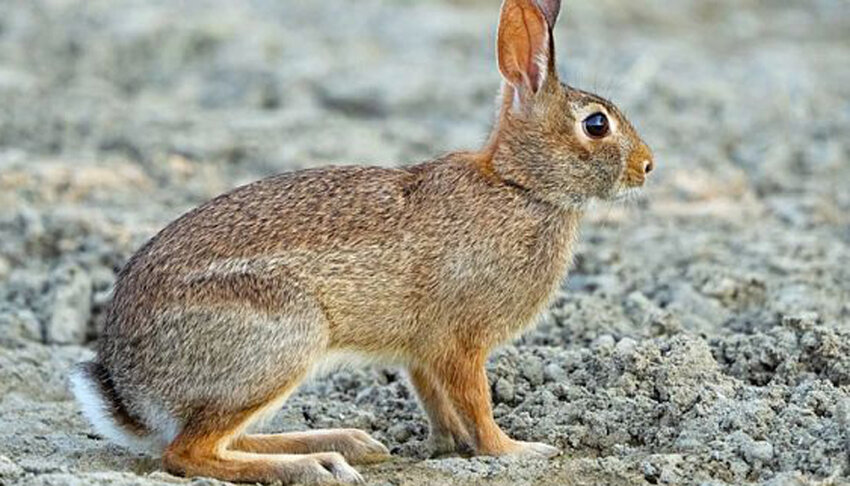
By James Card
An employee at the Chain One Stop called 911 at 2 p.m. on July 30 to report a female driver who drove her Jeep Liberty into the ditch and struck her head. The woman said she swerved to avoid hitting a rabbit.
There are many people in the area commenting about observing an unusually high number of cottontail rabbits this summer. Kelly Koch, owner of Doc Kelly’s Public House, lives in the town of Farmington. He said his property is overrun with rabbits this year. This has attracted a bobcat that skulks around every evening looking for an easy dinner.
The Waupaca County Post contacted Jacob Fries, a DNR wildlife biologist at Hartman Creek State Park, for clues about the high number of rabbits this year.
The DNR does not have population estimates for rabbits year to year like they do for other animals such as whitetail deer. They work under the assumption that the rabbit population is generally healthy and there are several million in the state at any given time.
Snowshoe hares and ruffed grouse populations have population cycles that rise and crash over decades. Cottontail populations will have some ups and downs from year to year but not in such repeatable cycles.
Rabbits breed early in the spring and have their first young in April. A doe will have two or three litters per year with an average of six per litter. They are able to breed the day after they give birth.
“Right in that range of averages, we could have a pair of rabbits turn into 18 rabbits just though the course of the summer. They have this tremendous ability to increase their population rapidly. That’s how they survive onto the next year and individually, the species doesn’t live long. The average rabbit doesn’t live a year but it has 18 kids to replace it,” said Fries.
His theory on this year high rabbit population has to do with the weather.
“I think the very wet spring caused a lot of vegetation to be lush, thick and tall. With delayed or altered mowing on people yards, rabbits were more successful at reproducing. They had more cover. In a backyard that isn’t mowed one week because of rain, so you miss it and you have a two-week period where that lawn isn’t mowed and there is six to eight-inch grass, that is enough time for a rabbit to get in there and make a nest and get a brood of young out of there. That habitat may have not been available to them other years,” said Fries.
He observed this phenomenon before when he tried a No-Mow May, the practice of not mowing a yard in May to let flowers bloom to help pollinators. When Fries resumed mowing, he saw several rabbit nests that would not have been there if he had been mowing during the month of May. He suspects a similar dynamic was at play during the rainy spring and early summer.
“Grass that’s mowed to your standard three-inch lawn mower height, they stick out like a sore thumb. But a five or six-inch grass, they really can hide in it. So I think this are subtle difference that we are seeing now mid-summer. How many people’s vegetable garden got away from them in June this year? They are small little habitat features. If you have two of those things happening on your property, you went from two rabbits to 12 in a hurry and that’s what is very noticeable and that’s what people are talking about I think,” said Fries.
He doesn’t think the warm winter was much of a factor. Winter isn’t too hard on rabbits. The only advantage and disadvantage is their coloration: their brown bodies against the snow expose them to predation; likewise they blend in well on a snowless forest landscape.
For problem rabbits in the garden that must be dealt with, Wisconsin has a 2023 state statute that allows landowners and family members to hunt or trap rabbits anytime of the year and without a license. This also includes, beaver, coyotes, foxes, raccoons, woodchucks and squirrels. The only time this is not allowed is 24 hours before the opening day of the state’s deer hunting firearm season. Those within city limits where firearm restrictions are in place, may use live traps.
Hunters in the Waupaca area can extend their rabbit hunting season because the rabbit hunting zone bisects the county. The northern zone is defined as being north of U.S. Highway 10 to Waupaca and north of State Highway 54 to Algoma. The southern zone is everything under that line. The northern zone season starts Sept. 14 and runs until Feb. 28, 2025. The southern zone season starts Oct. 19 and ends Feb. 28, 2025.
A Waupaca-area rabbit hunter could kick off the season in mid-September and hunt properties north of U.S. 10 and a month later migrate to hunting spots south of the highway. The bag limit for cottontail rabbits is three per day.
Rabbits can be eaten year-round and are safe to eat when fully cooked. One risk to humans is tularemia, also known as “rabbit fever.” The disease is transmitted through flea and tick bites. There is a myth that eating rabbits before first frost prevents this; however, rabbits can have fleas in the winter, too. The best practice is to wear rubber gloves when skinning rabbits.
There is another rabbit-related risk. A successful hunter can eat too many rabbits that leads to a condition called “rabbit starvation,” also known as protein poisoning. It’s a form of malnutrition caused by a diet lacking fat and carbohydrates. The condition got its nickname because rabbit is very lean and has little fat.
This can be avoided by making German hasenpfeffer, a classic dish of marinated rabbit, onions, sour cream and dumplings.